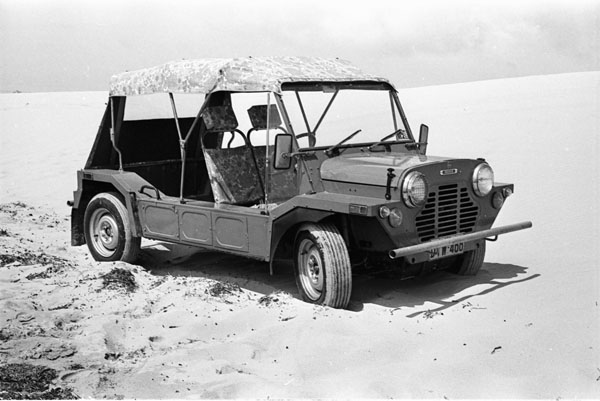In February 1966, the Mini-based Moke went on sale. This lightweight two-wheel drive vehicle combined Mini mechanicals with a buckboard-style body without doors and windows.
The concept originated in Britain in 1956, as a light army personnel carrier for use on and off normal roads. Some four-wheel drive prototypes were built but they never went into production.
Production of the 2WD versions started in Britain but sales were too slow for the parent company so the decision was made to transfer production to Sydney. A similar vehicle was also produced in Portugal until the late 1980s.
The Moke’s body sat on a punt-type chassis structure made from steel pressings. A foldaway fabric hood was fitted and the all-steel, welded body had two seats as standard and pannier boxes along each side to house the battery, fuel tank and tool kit.
A major criticism of the Moke was its lack of ground clearance, caused by using the same 10-inch wheels as the normal sedan. In 1968 this was rectified to an extent when BMC offered 13-inch wheels, initially as an option, and improved the suspension travel. A year later, the `Mini Moke/Mini Joke’ further improved its performance when the 1.1-litre engine from the Mini K sedan was fitted. The resultant increase in power and torque made the Moke a more competent performer in rough terrain.
In 1971 a new version of the Moke – known as the Californian – was released. Where the original Moke was aimed at farmers unable to afford a Land Rover, the Californian was pitched at the younger generation. The Moke Californian had a wider range of body colours and improved seats, while the vinyl softtop boasted a multicoloured paisley design. In 1977 a special dressed-up version of the Californian was introduced. This featured wider white-spoke wheels, a rear-mounted fuel tank and other changes.
To help promote the Californian, Leyland Australia entered one in the 1977 London-to-Sydney Car Rally. This event, which was first run in 1968, covered more than 30,000 km in 30 days, starting at the Covent Garden Opera House and finishing at the Sydney Opera House.
The Moke suffered only two mechanical faults: a cracked inlet manifold (replaced in Yugoslavia) and a broken tie rod near Kulgera, south of Alice Springs. The crew also had to replace three tyres, two shock absorbers and the canvas hood. From a field of 75 vehicles, 49 finished including the diminutive Moke, which crossed the line in a creditable 35th place.
Production of Australian Mokes ceased in 1981, by which time 26,142 had been built downunder for local and overseas markets.









